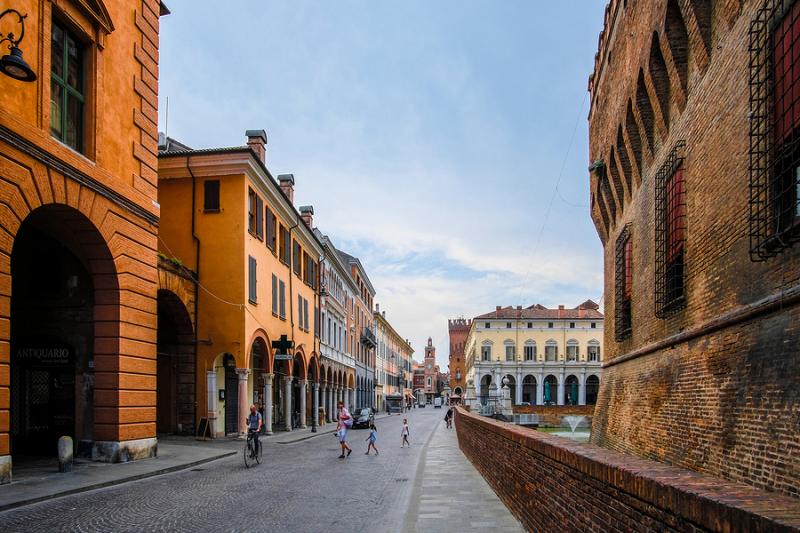Unesco Sites of Italy: Ferrara, City of the Renaissance, and its Po Delta
ITA:

Use player to listen to Italian version
Ferrara, a pleasant, bike-friendly small town in Emilia-Romagna, has been a Unesco World Heritage site since 1995, along with the surrounding agricultural lands of the vast Po river delta.
The area comprised within the Unesco site includes the medieval city within the ring of defensive walls that were erected starting in the 12th century, and subsequent extensions, which now comprise the Cathedral of San Giorgio and the Estense Castle; in other words, its historic center.
From the 14th to the 16th centuries, under the powerful House of Este, a number of urban planning schemes were implemented, “which made Ferrara the first Renaissance city to be developed using a complex urban plan.” As Unesco puts it, “In this plan, the network of streets and walls were closely linked with the palaces, churches and gardens as part of an overall scheme that gave precedence to the harmonious layout of urban perspectives, rather than accentuating the beauty of individual buildings.”
The most famous of these plans dates to the end of the 15th century and is known as Addizione Erculea; designed by the architect Biagio Rossetti, it is one of the first urban plans based on the idea of perspective.
Renaissance Ferrara is exceptionally well preserved, according to Unesco, its layout easily understood by visitors.
The Po Delta of the Po River valley has been settled for thousands of years. From the 14th to the 16th centuries, the ruling Este family carried out extensive land reclamation and building projects; among them, the construction of a network of noble residences known as the delizie estensi, designed to mirror the image of the Court beyond the urban confines.
During the two seminal centuries of the Renaissance, the court of the Este family attracted leading artists, poets and philosophers, including Piero della Francesca, Jacopo Bellini, Andrea Mantegna, and even Michelangelo. Thus it became a major center for the development of ‘new humanism’ in Italy, equal in importance to Florence and Venice.
Ferrara, piacevole cittadina dell’Emilia-Romagna nota anche come ‘città delle biciclette’, è stata dichiarata Patrimonio dell'Umanità dall'Unesco nel 1995, insieme alle terre agricole circostanti parte del vasto delta del fiume Po.
L'area compresa all'interno del sito Unesco consiste nella città medievale situata all'interno della cerchia di mura difensive che furono erette a partire dal 12° secolo, più gli allargamenti successivi, che comprendono la cattedrale di San Giorgio e il Castello Estense; in altre parole, il centro storico.
Dal XIV° al XVI° secolo, durante il dominio della potente Casa d'Este, furono attuati diversi schemi di pianificazione urbana, "che fecero di Ferrara la prima città del Rinascimento a svilupparsi secondo un complesso piano urbanistico". Come afferma l'Unesco, “In questo piano, la rete di strade e mura era strettamente collegata con i palazzi, le chiese e i giardini, parte di uno schema generale che dava la precedenza alla disposizione armoniosa delle prospettive urbane, piuttosto che accentuare la bellezza del singolo edificio.”
Il più famoso di questi piani risale alla fine del XV° secolo ed è noto come Addizione Erculea; progettato dall'architetto Biagio Rossetti, è uno dei primi piani urbanistici basati sull'idea della prospettiva.
La Ferrara del Rinascimento è eccezionalmente ben conservata, secondo l'Unesco, e la sua struttura urbana facilmente comprensibile dai visitatori.
Il Delta del fiume Po nell’omonima valle è abitato da migliaia di anni. Dal XIV° al XVI° secolo, la dinastia degli Este realizzò ampi progetti di bonifica e costruzione di edifici; tra questi, la realizzazione di un circuito di residenze nobili conosciute come le ‘delizie estensi’, progettate per rispecchiare l'immagine della Corte oltre i confini urbani.
Durante i due secoli fondamentali del Rinascimento, la corte della famiglia Este attirò importanti artisti, poeti e filosofi, tra cui Piero della Francesca, Jacopo Bellini, Andrea Mantegna e persino Michelangelo. Così divenne un importante centro per lo sviluppo del ‘nuovo umanesimo’ in Italia, di pari importanza a Firenze e Venezia.











